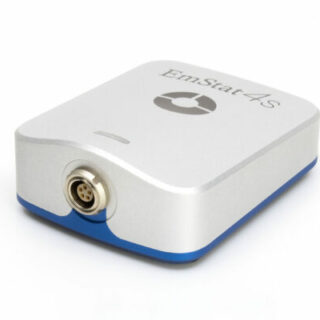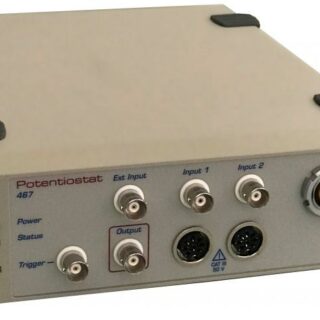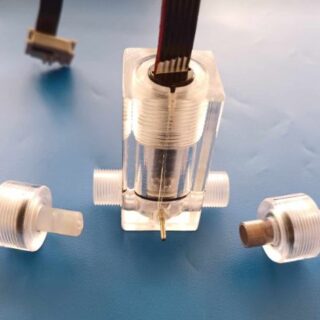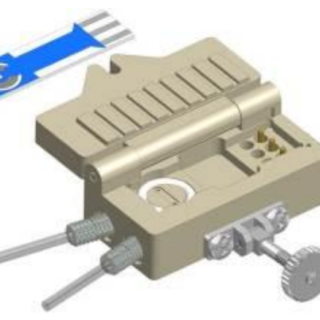Category
- Custom made glass products
- CUSTOMER SERVICES
- NEW PRODUCTS
- Sensors and electrodes
- Custom made and Modified Screen Printed Electrodes
- Stirrers
- Cables and connectors
- Cell
- Potentiostats
- Manual Screen Printer
- Minithermostat
- Pumps
- Accessories
- Kits & Sets
- Discounted SPEs (at a reduced price with visual defects/inconsistancies, but fully functional)
Archives: Products
Showing 49–64 of 127 results
-
EA164 QuadStat
Read more- Four-channel potentiostat 10mA to 200pA range
- Separate/common reference and auxiliary electrodes
- BiPotentiostat
- Ideal for amperometric biosensors, microbial fuel cells, photovoltaic materials and neurochemistry
The QuadStat is a software-controlled four-channel potentiostat with many Research Advantages (see below). Each channel can be used as a single three-electrode potentiostat. Alternatively two (bipotentiostat), three, or four working electrodes can be used in a single reaction chamber with a common reference and auxiliary electrode. Potential at each working electrode can be independently adjusted between ±2.5 V, or by using an external waveform generator to between ±10 V. The QuadStat can measure currents from pico- to milliamperes, making it ideal for amperometric biosensor research including use as a multichannel monitor for in vivo nitric oxide or dissolved oxgen sensors.
Two QuadStats can be ‘piggybacked’ to provide eight potentiostat channels.
By connecting the corresponding auxiliary and reference electrode leads, the QuadStat can be used as a four channel two-electrode (working and counter electrode) potentiostat. There is also a zero resistance ammeter (ZRA) mode of operation on each channel.
More information can be found through the link: https://www.edaq.com/EA164
-
EA362 Dual PicoStat
Read more- High sensitivity 2 channel potentiostat
- Bipotentiostat and 4-electrode modes of operation
The Dual PicoStat is a two channel high sensitivity potentiostat suitable for use with carbon fiber and ultramicroelectrodes for the monitoring of low current signals (down to picoameperes). It is commonly used for in vivo monitoring of dopamine by amperometry.
There are two potentiostat channels which enable the unit to also be used as a bipotentiostat (two working electrodes with a common reference and auxiliary electrode) so that dopamine levels can be monitored at two separate locations. Alternatively it can be used to perform duplicate experiments with separate samples, each with a working, reference and auxiliary electrode.
It can also be used as a 4-electrode voltage clamp (with two current passing and two voltage sensing reference electrodes) for studies of ionic transport across membranes or immiscible interfaces.
The Dual PicoStat is electrically isolated and is resistant to interference from neural stimulators, and ground loops. It is DC powered and can be used inside Faraday cages if required.
More information can be found through the link: https://www.edaq.com/EA362
-
EmStat4R
Read moreThe EmStat4R delivers desktop performance in a rugged enclosure. The EmStat4R is a portable Battery or USB-powered Potentiostat, Galvanostat, and optional a Frequency Response Analyzer (FRA) for Electrochemical Impedance Spectroscopy (EIS).
The EmStat4R is great for applications that require low currents, from 30 mA down to picoamps, such as sensor applications. The EmStat4R is controlled with PSTrace for Windows, the Android app PStouch, or you can write your own MethodSCRIPT and control it from any platform or operating system.
More information can be found through the link: https://www.palmsens.com/product/emstat4r/
- Portable: battery, Bluetooth and rugged housing
- Available with connection module for sensor cable or SPE
- Potential range ±3 V
- Max. current ±30 mA
- Optional impedance analyzer: 10 μHz up to 200 kHz
Two versions
The EmStat4R is available with a cell cable or SPE connection module. Both versions can be configured with optional EIS/FRA with a maximum frequency of 200 kHz. See specifications for more information.
EmStat4R SNS EmStat4R SPE 

Connection module Cell cable Connection module Screen-printed-electrode Cell cable included Yes Cell cable included No Electrode connections WE, RE, CE and ground Electrode connections RE, WE, CE Connectors 2 mm banana Sensor pitch 2.54 mm Maximum sensor width 11 mm Allowed sensor thickness Between 0.1 mm and 0.8 mm Always a backup
The EmStat4R is equipped with 500 MB internal storage memory for storing your measurements as a backup. All internally stored measurements can be browsed and transferred back to the PC easily using the PSTrace software for Windows. Your data is always with your instrument wherever you take it.
Standard included
A standard EmStat4R includes a rugged carrying case with:

- EmStat4R
- Rugged case
- USB-C cable
- Cell cable: high quality, double-shielded cable with 2 mm banana connectors for Working, Counter, Reference electrode and Ground
- 4 crocodile clips
- Dummy Cell
- PSTrace software for Windows (on USB drive)
- Manual (hardcopy)
- Quick Start document
- Calibration report
- Three year warranty
-
EmStat4S
Read moreThe EmStat4S delivers desktop performance in the palm of your hand. The EmStat4S is a portable USB-powered Potentiostat, Galvanostat, and optional a Frequency Response Analyser (FRA) for Electrochemical Impedance Spectroscopy (EIS). The EmStat4S is controlled with PSTrace for Windows, or you can write your own MethodSCRIPT and control it from any platform or operating system.
More information can be found through the link: https://www.palmsens.com/product/emstat4s/
Versions
The EmStat4S comes in two different versions:
- Low Range: for lower currents and potentials
- High Range: for higher currents and potentials
Both versions can be configured with optional EIS/FRA with a maximum frequency of 200 kHz.
Main differences between the EmStat4S Low and High Range 



Potential range ±3 V ±6 V Max. compliance voltage
±5 V ±8 V Current ranges 1 nA to 10 mA (8 ranges) 100 nA to 100 mA (7 ranges) Max. current ±30 mA ±200 mA Electrode connections WE, RE, CE and ground,
2 mm banana plugsWE, RE, CE, Sense, and ground,
2 mm banana plugsStandard included
A standard EmStat4S includes a rugged carrying case with:

- EmStat4S
- USB-C cable
- Sensor cable: high quality, double-shielded cable with 2 mm banana connectors for Working, Counter, Reference electrode and Ground
- 4 or 5 crocodile clips
- Dummy Cell
- PSTrace software for Windows (on USB drive)
- Manual (hardcopy)
- Quick Start document
- Calibration report
-
EmStat4X
Read moreThe EmStat4X delivers high performance in a small footprint. The EmStat4X is a small battery and USB-powered Potentiostat, Galvanostat, and optional Frequency Response Analyser (FRA) for Electrochemical Impedance Spectroscopy (EIS).
The EmStat4X Low Range (LR) version is great for applications that require measuring low currents down to picoamps, like (bio)sensor research. The High Range (HR) version is very suitable for applications that need a maximum current of up to 200 mA. The EmStat4X is controlled with PSTrace for Windows, or you can write your own MethodSCRIPT and control it from any platform or operating system.
More information can be found through the link: https://www.palmsens.com/product/emstat4s/
The EmStat4X LR and HR features include:
- Fast EIS support: for running fixed-frequency EIS measurements at a very low interval of around 1 ms.

- Auxiliary Port: for connecting to a MUX8-R2 multiplexer, temperature sensor, pH sensor, stirrer control, triggering and more.
- iR compensation: to compensate for the iR drop between the Reference electrode and the outside of the double layer of the electrochemical cell.
- Bluetooth: for a wireless connection to a PC, smartphone or tablet
- 11.1 Wh battery: for more than 8 hours of continuous measurements (typical with the LR).
- Small borderless display: showing the state of the battery and connectivity.
Two versions
The EmStat4X comes in two different versions:
- Low Range: for lower currents and potentials (±30 mA / ±3 V applied / ±5 V compliance)
- High Range: for higher currents and potentials (±200 mA / ±6 V applied / ±8 V compliance)
Both versions can be configured with optional EIS/FRA up to 200 kHz.
See specifications for a detailed comparison between the LR and HR.Always a backup
The EmStat4X is equipped with 500 MB internal storage memory for storing your measurements as a backup. All internally stored measurements can be browsed and transferred back to the PC easily using the PSTrace software for Windows. Your data is always with your instrument wherever you take it.
Standard included
A standard EmStat4X includes a rugged carrying case with:
- EmStat4X LR or HR

- USB-C cable
- Cell cable: high quality, double-shielded cable with 2 mm banana connectors for Working, Counter, Reference electrode and Ground, 1 meter long
- 4 or 5 crocodile clips
- Dummy Cell
Also included:
- PSTrace software for Windows (on USB drive)
- Manual (hardcopy)
- Quick Start (hardcopy)
- Calibration report
- Fast EIS support: for running fixed-frequency EIS measurements at a very low interval of around 1 ms.
-
EmStatMUX8-R2
Read moreUSB powered potentiostat with integrated multiplexer
- potentiostat with integrated 8 channel multiplexer
- potential range: ± 3V or ± 4V
- compliance voltage: ± 5V or ± 8V
- current ranges: 1 nA – 100 mA
- maximum current: ± 100 mA
With the EmStat3MUX8-R2 you can connect arrays or other setups made of up to eight working electrodes in two or three electrode cell types. If more channels are required, one or more MUX-R2 can be stacked to the EmStatMUX8-R2 for a total of up to 128 channels.
The potentiostat is controlled as well as powered by USB and is used with PSTrace. The MUX8-R2 can sample different cells at a rate of 25 ms/cell. Usually a method needs to be finished to switch the cell but the fast sampling per cell makes it possible to measure time depending techniques, e.g. chronoamperometry, practically simultaneously. Via the script window of PSTrace it is also possible to perform a different experiment on each of the channels sequentially.
More information can be found through the link: https://www.palmsens.com/product/emstatmux/
Specifications
With EmStat potentiostat version 3 3+ dc-potential range
± 3.000 V ± 4.000 V compliance voltage
± 5 V ± 8 V dc-potential resolution 0.1 mV 0.125 mV dc-potential accuracy 0.2 % 0.3 % current ranges
1 nA to 10 mA (8 ranges) 1 nA to 100 mA (9 ranges) maximum current ± 20 mA typical
and ± 15 mA minimum± 100 mA typical The current is measured using a zero resistance ammeter (ZRA).
Cell connections
There are four ways to connect your sensor. These sensor connections are quoted separately.
- Option A: Double shielded sensor cables with 2 mm banana connectors. The 2 mm banana connectors are compatible with standard croc clips (they will be included in the quotation as optional).
- Option B: High-density cable that terminates in ferrules
- Option C: Connection (Screw) Terminal to assemble your own wires.
- Option D: Screen Printed Electrode Connector
Each of these connection options can be used to connect 4 channels. When you add the EmStatMUX8 in the quotation basket we will make sure to include two units of the selected connection option so you can connect all 8 channels to the electrochemical cells.

-
Epsilon EClipse
Read moreThe Epsilon EClipse is the latest electrochemical analyzer manufactured by BASi.
It is a potentiostat/galvanostat with a second working electrode for bipotentiostat measurements. Software with the most popular electrochemistry techniques is included with the instrument.
More information can be found through the link: https://www.basinc.com/epsilon/eclipse
This System Includes:
- Basic Software – techniques include
- Cyclic Voltammetry/Linear Sweep Voltammetry
- Chronoamperometry/Chronocoulometry
- Controlled Potential Electrolysis
- DC Potential Amperometry
- Open Circuit Potential vs. Time
- Chronopotentiometry
- Basic Plus Software – techniques include
- Sampled Current Polarography
- Normal Pulse Voltammetry/Polarography
- Differential Pulse Voltammetry/Polarography
- Square Wave Voltammetry
- Stripping Voltammetry Techniques
- Double Potential Step Chronopotentiometry
- Methods Software – techniques include
- Prepare sequences with an unlimited number of techniques
- Insert trigger and delays in sequence
- Repeat sequence up to 9999 times
- Bi-Potentiostat – techniques include
- Multi-Channel Amperometry
- Multi-Channel Cyclic Voltammetry
- Multi-Channel Chronoamperometry
10’ USB Cable
Bi-Potentiostat cell lead cableSpecifications:
Potentiostat
- Channel 1 applied potential: Dynamic DAC: 16 bit, ±3.275 V @ 0.1 mV resolution or ±10 V @ 0.33 mV resolution
- Offset DAC: 8 bit, ±2.55 V @ 10 mV resolution
- Channel 2 applied potential: Dynamic DAC: 8 bit, ±2.55 V @ 10 mV resolution
- Compliance voltage: ±12 V
- Maximum current: 100 mA
- Bandwidth: > 100 kHz
- Bias current: < 1pA
- Electrometer input impedance: > 1012W
- (values for parameters other than applied potential are for both channels)
Current-to-voltage converter
- Full scale sensitivity: 1 nA*, 10 nA*, 100 nA, 1 µA, 10 µA, 100 µA, 1 mA, 10 mA,100 mA, (*secondary gain used)
- Secondary gain: x1, x10, and x100
- ADC resolution: 16 bit
- Sampling rate: 50 kHz (20 µs/conversion)
- Data length: up to 64k points – fast
Galvanostat
- Applied current: 50 pA – 50 mA
- Range: ±10 V ± 1 V
- Measured potential resolution: 0.02 mV
- Max leakage current: 30 pA
I/O
- Eout (applied potential)
- Iout (current to voltage output)
- Ein (input connection for external applied wave form)
- Cell Stand port (control of C-3 Cell Stand and CGME)
- Ordering Port (control of RDE-2)
- PC (USB) port
- Trigger out (TTL)
Minimum PC requirements
- Win 7 or higher
- Pentium III
- 512 MB RAM
- 50 MB hard drive space available
- USB port
Power requirements
- 120 or 240 VAC, 50/60 Hz, 60 VA
Dimensions & weight
- 15.75″ (40 cm) x 5.25″ (13 cm) x 12.75″ (32.5 cm)
- 17.5 lb (7.4 kg) (1 channel)
- Basic Software – techniques include
-
ER461 EChem Startup System
Read moreMost popular eDAQ potentiostat
Potentiostat, galvanostat, ZRA and electrometer modes
Maximum 100 mA and ±10 VOpen your lab to the world of electrochemistry with the economically priced EChem Startup System. It has just about everything you need for most voltammetric experiments. The system is ideal for both research and teaching experiments, and especially for compound characterization with cyclic voltammetry.
More information can be found through the link: https://www.edaq.com/ER461
System Components:
• ER466 Integrated Potentiostat System
• ET014 EChem Electrode Kit
• ES260 EChem Software
• ES500 Chart and Scope SoftwareThe ER466 Integrated Potentiostat System is our most popular potentiostat model, being ideal for cyclic, linear sweep, and most analytical pulse voltammetric experiments, either in the research or teaching laboratory. It also functions as a galvanostat, ZRA (zero resistance ammeter), and high impedance voltmeter (electrometer). Connection to a computer is via a USB cable.
The EChem Electrode Kit contains gold, platinum and glassy carbon working disk electrodes. Reference and auxiliary electrodes are also included, together with two 3 mL reaction vials and a stand. The electrodes are suitable for use with the eDAQ potentiostats, and can be used in a variety of electrochemical applications.
Working electrodes, 1 mm disk, PEEK body:
ET074-1 Glassy carbon
ET075-1 Platinum
ET076-1 GoldReference electrode: ET072 Leakless Ag/AgCl
Auxiliary electrode: ET078-1 Pt coated titanium rod, 1.6 mm diameter
Two 3-mL reaction vessels with stirrer vane, drilled PTFE gasket and holder
Lead wire clampAvailable Techniques:
• Cyclic Voltammetry
• Linear Sweep Voltammetry *
• Square Wave Voltammetry *
• Normal Pulse Voltammetry *
• Differential Pulse Voltammetry *
• Multi Pulse Voltammetry
• Multi Pulse Amperometry
• Chronoamperometry (single or multistep)
• Chronocoulometry (single or multistep)
• Chronopotentiometry (single or multistep)
• Controlled potential electrolysis
• Controlled current electrolysis* Also available in stripping mode for trace element determination. Metals such as copper, lead, cadmium and zinc can be determined in the ppb range even in an undergraduate lab (no clean room required!).
Battery technology, corrosion science, conducting polymer and electrosynthesis experiments can also be performed. -
ER466 Integrated Potentiostat System
Read more- Ideal for cyclic voltammetry, linear sweep and pulse techniques
- Potentiostat, galvanostat, ammeter and voltmeter modes
- Maximum 100 mA and ±10 V
- Expandable using isoPod amplifiers
- High accuracy
- Windows 7, 8 and 10 compatible
The ER466 Integrated Potentiostat System is our most popular potentiostat model, being ideal for cyclic, linear sweep, and most analytical pulse voltammetric experiments, either in the research or teaching laboratory. It also functions as a galvanostat, ZRA (zero resistance ammeter), and high impedance voltmeter (electrometer). Connection to a computer is via a USB cable.
More information can be found through the link: https://www.edaq.com/ER466
-
ER467 High Current Potentiostat
Read more- Ideal for cyclic voltammetry, linear sweep and pulse techniques
- Potentiostat, galvanostat, ammeter and voltmeter modes
- Maximum 1 amp and ±10 V
- Expandable using isoPod amplifiers
- Four-electrode potentiostat
- Windows 7, 8 and 10 compatible
The ER467 Potentiostat System is ideal for cyclic, linear sweep, and most analytical pulse voltammetric experiments, either in the research or teaching laboratory. It also functions as a galvanostat, ZRA (zero resistance ammeter), and high impedance voltmeter (electrometer). Connection to a computer is via a USB cable.
More information can be found through the link: https://www.edaq.com/ER467
-
FC.1ISE.1REF Flow cell for single ion selective electrode with integrated stirring
Read moreThe flow cell with integrated stirring and reduced hydrodynamic noise is designed for the determination of single analyte using one miniature ion-selective electrode (ISE) and one miniature reference electrode with a diameter of 6 mm and length of 60 mm.
Rotation speed of integrated stirrer: 10-4000 rmp.
Miniature ion-selective electrodes and reference electrode were designed for integration into the flow cell for determination of Cl-, K+, Ca2+ and Na+ ions.
In flow mode, the system can operate automatically. The speed of the integrated stirrer can also be controlled by applying the corresponding voltage to the motor, connected to a stabilized source.
The flow cell with one selected ISE can be used for:
- Automatic or semi-automatic measurement of concentration of Cl-, K+, Ca2+ and Na+ ions in various solutions (following prior calibration)
- For continuous measurement of changes in concentration of Cl-, K+, Ca2+ and Na+ ions.
* For this product, we recommend our customers use the Training Service from BVT.
(https://bvt.cz/produkt/offer-of-long-term-automated-measurements-on-bvt-apparatus/)
-
FC2.TL.* PMMA Flow Cell
Read moreThe flow cell enables the use of Screen printed sensors in a flow through arrangement.
The flow cell is suitable for sensors of type AC1, AC2, CC1, CC2 and CC3.
The Screen printed sensor is inserted into the slit of cell and tightened by closing of the door. The cell ensures the wall-jet flow around the working electrode and it is optimised so that no air bubbles cumulate in the cell. The cell contains also the contact and output cable.
With the sensors enclosed in a flow cell, it is possible to measure semi-automatically or automatically using a pump or liquid switch for sample supply. Under such conditions, maximum measurement reproducibility is ensured.
-
FC3.TL.* LED Flow Cell
Read moreThe flow cell enables the use of Screen printed sensors in a flow through arrangement for spectroelectrochemical measurements1,2.
The flow cell is suitable for sensors of type AC1, AC2, CC1, CC2 and CC3.
The Screen printed sensor is inserted into the slit of cell and tightened by closing of the door. The cell ensures the wall-jet flow around the working electrode and it is optimised so that no air bubbles cumulate in the cell. The cell contains also the contact and output cable.
With the sensors enclosed in a flow cell, it is possible to measure semi-automatically or automatically using a pump or liquid switch for sample supply. Under such conditions, maximum measurement reproducibility is ensured.
LED Specification:
Diameter: 3 mm
Wave lenght range: 350 – 2000 nm- Standard: 620 – 630 nm
(If special laser LED is used the band width and other parameters can be specified on demand)
Emitting angle: 10 – 120 deg
- Standard: 60 deg
Iv (emitted power): 750 – 1120 mcd
I max: 20 mA - Standard: 620 – 630 nm
-
FC4.TL.* PEEK Flow Cell
Read moreThe FC4.TL flow cell is made of PEEK and enables the use of Screen printed sensors in a flow through arrangement.
It has teflon endings permitting a fully compatible connection to chromatography tubing.
The flow cell is suitable for sensors of type AC1, AC2, CC1, CC2 and CC3.
The Screen printed sensor is inserted into the slit of cell and tightened by closing of the door. The cell ensures the wall-jet flow around the working electrode and it is optimised so that no air bubbles cumulate in the cell. The cell contains also the contact and output cable.
With the sensors enclosed in a flow cell, it is possible to measure semi-automatically or automatically using a pump or liquid switch for sample supply. Under such conditions, maximum measurement reproducibility is ensured.
-
Hanging Platinum Drop Electrode
Read moreThe Hanging Platinum Drop Electrode (HPDE) is solid phase alanogy of HMDE.
The drop of liquid Pt at 2000 °C forms a drop of Pt. The surface of HPDE has nearly ideal surface which is impossible to obtain using polishing. HPDE has also spherical symmetry which enables mathematical treatment of its response.
The material is not toxic and it is chemically stable. The only disadvantage is HPDE cleaning, which can be, however, in some cases solved by carefull insertion of the electrode tip to the flame of an alcohol burner.
Thus HPDE can be used as reference electrode for complicated electrochemical studies, where it is necessary to distinguish the analytical signal from the signal generated by surface inhomogenities.Hanging platinum drop electrode (HPDE) is designed for measurements with thermostated cell TC4, TC5, TC6 and TC9.
-
ISE Ion Selective Electrodes
Read moreIon Selective Electrodes, ISEs, are analytical tools widely used for potentiometric analysis of large scale of various ionic analytes.
ISEs enable routine analysis in agriculture, food process, soil analysis, environmental anylysis, tribotechnical analysis, explosives and pyrotechnical mixtures analysis. They can be used for water, pot-, waste-, boiler-, mineral-, and well water samples.
These electrodes allow for direct measurements of Ammonium, Lithium, Sodium, Calcium, Fluoride, Nitrate, Potassium and Barium.
Electrodes are applicable to all commonly used measuring apparatus, with internal resistance of above 10^9 – 10^12 ohm.
Diameter: 12 mm.
Standard electrical connecting cable is 0.8 to 1 m. coaxial cable with BNC connector.
The work with ion selective electrodes is time effective, requires an only small amount of chemicals, and a friendly price of measuring equipment MPH472.
















